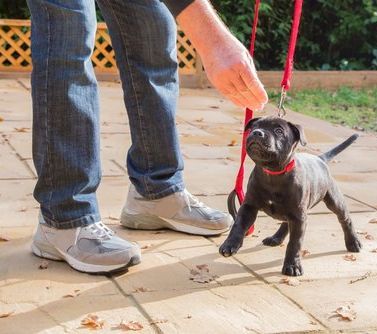Common Misconceptions about At-Home Corpus Christi Dog Training
At-Home Dog Obedience Training: Misconceptions Vs Reality
While at-home dog training offers numerous benefits, there are also some common misconceptions about this approach. One misconception is that at-home training is inherently easier than group classes. While it’s true that the familiar environment of your home can make some dogs more comfortable and relaxed, at-home training also requires a high level of dedication and commitment from the owner. In a group class setting, trainers can provide crucial guidance and support throughout the training process. They can demonstrate techniques, answer questions, and troubleshoot any challenges that arise. This can be especially helpful for first-time dog owners or those unfamiliar with dog training principles. Additionally, trainers can anticipate common mistakes and proactively address them before they become ingrained habits. In contrast, at-home training places more responsibility on the owner to correctly implement the training plan and identify areas where their dog might be struggling.
A second misconception is that dogs learn better in their own environment. There's some truth to the idea that a familiar environment can reduce stress and distractions for dogs. However, well-designed group classes offer a controlled environment with planned distractions to help dogs learn to focus and obey commands amidst various stimuli. This can be crucial for preparing a dog for the real world, where they'll encounter all sorts of sights, sounds, and smells that could potentially distract them from listening to their owner. For example, a group class might incorporate sounds like traffic noise or sirens, or introduce the dogs to other dogs or people in a structured way. At-home training can be supplemented with socialization outings to parks, dog-friendly stores, or puppy playdates to address this aspect of a dog's training.
Speak With A Dog
Training Expert
Speak With A Dog Training Expert
Thank you for contacting us!
We will contact you shortly!
Please try again later.

At-Home Dog Obedience Training: Misconceptions Vs Reality
While at-home dog training offers numerous benefits, there are also some common misconceptions about this approach. One misconception is that at-home training is inherently easier than group classes. While it’s true that the familiar environment of your home can make some dogs more comfortable and relaxed, at-home training also requires a high level of dedication and commitment from the owner. In a group class setting, trainers can provide crucial guidance and support throughout the training process. They can demonstrate techniques, answer questions, and troubleshoot any challenges that arise. This can be especially helpful for first-time dog owners or those unfamiliar with dog training principles. Additionally, trainers can anticipate common mistakes and proactively address them before they become ingrained habits. In contrast, at-home training places more responsibility on the owner to correctly implement the training plan and identify areas where their dog might be struggling.
Speak With A Dog
Training Expert
Speak With A Dog Training Expert
Thank you for contacting us!
We will contact you shortly!
Please try again later.
A second misconception is that dogs learn better in their own environment. There's some truth to the idea that a familiar environment can reduce stress and distractions for dogs. However, well-designed group classes offer a controlled environment with planned distractions to help dogs learn to focus and obey commands amidst various stimuli. This can be crucial for preparing a dog for the real world, where they'll encounter all sorts of sights, sounds, and smells that could potentially distract them from listening to their owner. For example, a group class might incorporate sounds like traffic noise or sirens, or introduce the dogs to other dogs or people in a structured way. At-home training can be supplemented with socialization outings to parks, dog-friendly stores, or puppy playdates to address this aspect of a dog's training.


A third misconception is that at-home training is only for basic obedience. In reality, a qualified at-home trainer can address a wide range of behavioral issues, from common problems like leash pulling and barking to more complex challenges like separation anxiety and aggression. The trainer will design a customized training plan specifically tailored to the dog's needs and the owner's goals. At-home training allows for a more in-depth exploration of the specific triggers and behaviors associated with a dog's problem, and the trainer can directly observe the dog's behavior in the environment where the problems occur.
Is There A Need For A Professional Dog Trainer?
A fourth common misconception is that any pet owner can successfully train their dog at home.
A third misconception is that at-home training is only for basic obedience. In reality, a qualified at-home trainer can address a wide range of behavioral issues, from common problems like leash pulling and barking to more complex challenges like separation anxiety and aggression. The trainer will design a customized training plan specifically tailored to the dog's needs and the owner's goals. At-home training allows for a more in-depth exploration of the specific triggers and behaviors associated with a dog's problem, and the trainer can directly observe the dog's behavior in the environment where the problems occur.
Is There A Need For A Professional Dog Trainer?
A fourth common misconception is that any pet owner can successfully train their dog at home. At-home dog training can be a successful option for many pet owners, but it's important to be realistic about the commitment required. Some behavioral issues, particularly those rooted in fear or aggression, may benefit from the combined expertise of a professional trainer and animal behaviorist. A qualified trainer can assess the situation and recommend the most appropriate training approach, which might involve a combination of at-home training sessions, group classes, and additional resources.
The effectiveness of at-home training hinges on three key factors: the trainer's qualifications, the owner's dedication, and the dog's individual needs. A skilled trainer can create a personalized training program that is just as effective as the programs offered at professional training facilities. Ultimately, the success of any dog training program relies on the owner's commitment to consistent practice and positive reinforcement techniques.
At-home dog training can be a successful option for many pet owners, but it's important to be realistic about the commitment required. Some behavioral issues, particularly those rooted in fear or aggression, may benefit from the combined expertise of a professional trainer and animal behaviorist. A qualified trainer can assess the situation and recommend the most appropriate training approach, which might involve a combination of at-home training sessions, group classes, and additional resources.
The effectiveness of at-home training hinges on three key factors: the trainer's qualifications, the owner's dedication, and the dog's individual needs. A skilled trainer can create a personalized training program that is just as effective as the programs offered at professional training facilities. Ultimately, the success of any dog training program relies on the owner's commitment to consistent practice and positive reinforcement techniques.
